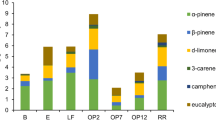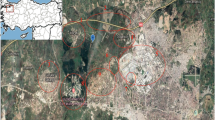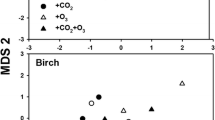Abstract
Experiments were conducted during the growing season of 1993 at a mixed deciduous forest in southern Ontario, Canada to investigate the atmospheric abundance of hydrocarbons from phytogenic origins, and to measure emission rates from foliage of deciduous trees. The most abundant phytogenic chemical species found in the ambient air were isoprene and the monoterpenes α-pinene and β-pinene. Prior to leaf-bud break during spring, ambient hydrocarbon mixing ratios above the forest remained barely above instrument detection limit (∼20 parts per trillion), but they became abundant during the latter part of the growing season. Peak isoprene mixing ratios reached nearly 10 parts per billion (ppbv) during mid-growing season while maximum monoterpene mixing ratios were close to 2 ppbv. Both isoprene and monoterpene mixing ratios exhibited marked diurnal variations. Typical isoprene mixing ratios were highest during mid-afternoon and were lowest during nighttime. Peak isoprene mixing ratios coincided with maximum canopy temperature. The diurnal pattern of ambient isoprene mixing ratio was closely linked to the local emissions from foliage. Isoprene emission rates from foliage were measured by enclosing branches of trees inside environment-controlled cuvette systems and measuring the gas mixing ratio difference between cuvette inlet and outlet airstream. Isoprene emissions depended on tree species, foliage ontogeny, and environmental factors such as foliage temperature and intercepted photosynthetically active radiation (PAR). For instance, young (<1 month old) aspen leaves released approximately 80 times less isoprene than mature (>3 months old) leaves. During the latter part of the growing season the amount of carbon released back to the atmosphere as isoprene by big-tooth and trembling aspen leaves accounted for approximately 2% of the photosynthetically fixed carbon. Significant isoprene mixing ratio gradients existed between the forest crown and at twice canopy height above the ground. The gradient diffusion approach coupled with similarity theory was used to estimate canopy isoprene flux densities. These canopy fluxes compared favorably with values obtained from a multilayered canopy model that utilized locally measured plant microclimate, biomass distribution and leaf isoprene emission rate data. Modeled isoprene fluxes were approximately 30% higher compared to measured fluxes. Further comparisons between measured and modeled canopy biogenic hydrocarbon flux densities are required to assess uncertainties in modeling systems that provide inventories of biogenic hydrocarbons.
Similar content being viewed by others
References
Aneja, V. P., Businger, S., Li, S., Claiborn, C. S., and Murphy, A., 1991: Ozone climatology at high elevations in the southern Appalachians, J. Geophys. Res. 96, 1007–1021.
Arey, J., Winer, A., Atkinson, R., Aschman, S., Long, W., Morrison, C., and Olszyk, D., 1991: Terpenes emitted from agricultural species found in California's central valley, J. Geophys. Res. 96, 9329–9336.
Baldocchi, D., Guenther, A., Harley, P., Klinger, L., Zimmerman, P., Lamb, B., and Westberger, H., 1995. The fluxes and air chemistry of isoprene above a deciduous hardwood forest, Phil. Trans. R. Soc. London A 350, 279–296.
Bottenheim, J. W. and Shepherd, M. J., 1995: C2−C6 hydrocarbon measurements at four rural locations across Canada, Atmos. Environ. 29, 647–664.
Brasseur, G. P. and Chatfield, R. B., 1991: The fate of biogenic trace gases in the atmosphere, in T. D., Sharkey, E. A., Holland, and H. A., Mooney (eds), Trace Gas Emissions from Plants, Academic Press, New York, pp. 1–27.
Burns, W. F., Tingey, D. T., Evans, R. C., and Bates, E. H., 1983: Problems with Nafion membrane dryer for drying chromatographic samples, J. Chromatogr. 269, 1–9.
Businger, J. A., Wyngaard, J. C., Izumi, Y., and Bradley, E. F., 1971: Flux-profile relationships in the atmospheric surface layer, J. Atmos. Sci. 28, 181–189.
Businger, J. A., 1966: Transfer of momentum and heat in the planetary boundary layer, Proceedings of the Symposium on Arctic Heat Budget and Atmospheric Circulation, the RAND Corporation, pp. 305–331.
Campbell, G. S., 1977: An Introduction to Environmental Biophysics, Springer-Verlag, New York, pp. 159.
Cellier, P., 1986: On the validity of flux-gradient relationships above very rough surfaces, Boundary-Layer Meteorol. 36, 417–419.
Cellier, P. and Brunet, Y., 1992: Flux-gradient relationships above tall plant canopies, Agric. For. Meteorol. 58, 93–117.
Chameides, W., Lindsay, R., Richardson, J., and Kiang, C., 1988: The role of biogenic hydrocarbons in urban photochemical smog: Atlanta as a case study, Science 241, 1473–1475.
Chen, F. and Schwerdtfeger, P., 1989: Flux-gradient relationships for momentum and heat over a rough natural surface, Q. J. R. Meteorol. Soc. 115, 335–352.
Clement, B., Riba, M. L., Leduc, R., Haziza, M., and Torres, L., 1990: Concentration of monoterpenes in a maple forest in Quebec, Atmos. Environ. 24, 2513–2516.
Dann, T. and Wang, D., 1995: Ambient air benzene concentrations in Canada (1989–1993): seasonal and day of the week variations, trends and source influences, J. Air and Waste Manage. Assoc. 45, 695–702.
Dann, T. F., Wang, D., Steenkamer, A., Halman, R., and Lister, M., 1994: Volatile Organic Compound Measurements in the Greater Vancouver Regional District (GVRD) During 1989–1992, Report No. PMD 91–1, Environmental Protection Service, Environment Canada, Ottawa, Ontario, pp. 57.
Delwiche, C. F. and Sharkey, T. D., 1993: Rapid appearance of 13C in biogenic isoprene when 13CO2 is fed to intact leaves, Plant, Cell Environ. 16, 587–591.
Fehsenfeld, F., Calvert, J., Fall, R., Goldan, P., Guenther, A. B., Hewitt, C. N., Lamb, B., Shaw, L., Trainer, M., Westberg, H., and Zimmerman, P., 1992: Emissions of volatile organic compounds from vegetation and the implications for atmospheric chemistry, Global Biogeochem. Cycles 6, 389–430.
Fuentes, J. D., Gillespie, T. J., and Bunce, N. J., 1994: Effect of foliage wetness on ozone deposition to red maple and poplar leaves, Water, Air Soil Pollut. 74, 189–210.
Fuentes, J. D., Wang, D., den, Hartog, G., Neumann, H. H., Deary, M. J., Dann, T. F., and Puckett, P. J., 1995a: Ambient Hydrocarbon Concentrations and Isoprene Emissions from Deciduous Trees at the Borden Forest During 1993, Report ARQD 95–002, Atmospheric Environment Service, Environment Canada, Downsview, Ontario, pp. 72.
Fuentes, J. D., Wang, D., den, Hartog, G., Neumann, H. H., Dann, T. F., and Puckett, P. J., 1995b: Modelled and field measurements of biogenic hydrocarbon emissions from a Canadian deciduous forest, Atmos. Environ. 29, 3003–3018.
Fuentes, J. D., Neumann, H. H., den Hartog, G., Wang, D., and Dann, T. F, 1995c: Emission rates and flux densities of isoprene from a boreal deciduous forest, in Abstract European Geophysical Union Conference, Germany, 3–9 April 1995.
Fuentes, J. D. and Gillespie, T. J., 1992: A gas exchange system to measure the effect of surface wetness on the deposition of pollutants, Atmos. Environ. 26, 1165–1173.
Finlayson-Pitts, B. J. and Pitts, J. N., 1993: Atmospheric chemistry of tropospheric ozone: scientific and regulatory implications, J. Air Waste Manage. Assoc. 43, 1091–1100.
Garrat, J. R., 1980: Surface influence upon vertical profiles in the atmospheric near-surface layer, Q. J. R. Meteorol. Soc. 106, 803–819.
Geron, C. D., Guenther, A. B., and Pierce, T. E., 1994: An improved model for estimating emissions of volatile organic compounds from forests in eastern United States, J. Geophys. Res. 99, 12773–12791.
Greenberg, J. D. and Zimmerman, P. R., 1984: Nonmethanehydrocarbons in the remote troposphere, J. Geophys. Res. 89, 4767–4778.
Grinspoon, J., Bowman, W., and Fall, R., 1991: Delayed onset of isoprene emission in developing velvet bean (Macuna Sp.) leaves, Plant Physiol. 97, 170–174.
Guenther, A., hewitt, C. N., Erickson, D., Fall, R., Geron, C., Graedel, T., Harley, P., Klinger, L., Lerdau, M., McKay, W. A., Pierce, T., Scholes, B., Steinbrecher, R., Tallamraju, R., Taylor, J., and Zimmerman, P., 1995: A global model of natural volatile organic compound emissions, J. Geophys. Res. 100, 8873–8892.
Guenther, A. B., Zimmerman, P. R., and Wildermuth, M., 1994: Natural volatile organic compound emission rate estimates for U.S. woodland landscapes, Atmos. Environ. 28, 1197–1210.
Guenther, A. B., Zimmerman, P. R., Harley, P. C., Monson, R. K., and Fall, R., 1993: Isoprene and monoterpene emission rate variability: model evaluations and sensitivity analysis, J. Geophys. Res. 98, 12609–12617.
Guenther, A. B., Monson, R. K., and Fall, R., 1991: Isoprene and monoterpene emission rate variability: observations with eucalyptus and emission rate algorithm development, J. Geophys. Res. 96, 10799–10808.
Isidorov, V. A., 1992: Non-methane hydrocarbons in the atmosphere of boreal forests: composition, emission rates, estimation of regional emission and photocatalytic transformation, Ecol. Bull. 42, 71–76.
Jakobson, H. B., Friis, P., Nielsen, J. K., and Olsen, C. E., 1994: Emission of volatiles from flowers and leaves of Brassica Napus in situ, Phytochem. 37, 695–699.
Jobson, B. T., Wu, Z., and Niki, H., 1994: Seasonal trends of isoprene, C2−C5 alkanes, and acetylene at a remote boreal site in Canada, J. Geophys. Res. 99, 1589–1599.
Khalil, M. A. K. and Rasmussen, R. A., 1992: Forest hydrocarbon emissions: relationships between fluxes and ambient concentrations, J. Air Waste Manage. Assoc. 42, 810–813.
Lamb, B., Gay, D., and Westberg, H., 1993. A biogenic hydrocarbon emission inventory for the U.S.A. using a simple forest canopy model, Atmos. Environ. 27, 1673–1690.
Lin, X., Melo, O. T., Hastie, D. R., Shepson, P. B., Niki, H., and Bottenheim, J. W., 1991: A case study of ozone production in a rural area of central Ontario, Atmos. Environ. 26, 311–324.
Loreto, F. and Sharkey, T. D., 1993: Isoprene emission by plants is affected by transmissible wound signals, Plant, Cell Environ. 16, 563–570.
Loreto, F. and Sharkey, T. D., 1990: A gas-exchange study of photosynthesis and isoprene emission in Quercus rubra L, Planta 182, 523–531.
Monin, A. S. and Obukhov, A. M., 1954: Basic laws of turbulence mixing in the ground layer of the atmosphere, Acad. Nauk. SSR. Trud. Geofiz. Inst. 24, 163–187.
Monson, R. K., Lerdau, M. T., Sharkey, T. D., Schimel, D. S., and Fall, R., 1995: Biological aspects of constructing volatile organic compound emission inventories, Atmos. Environ. 29, 2989–3002.
Monson, R. K., Harley, P. C., Litvak, M. E., Wildermuth, M., Guenther, A. B., Zimmerman, P. R., and Fall, R., 1994: Environmental and developmental controls over the seasonal pattern of isoprene emission from aspen leaves, Oecologia 99, 260–270.
Monson, R. K., Jaeger, C. H., Adams, W. W., Driggers, E. M., Silver, G. M., and Fall, R., 1992: Relationships between isoprene emission rate, photosynthesis, and isoprene synthase activity as influenced by temperature, Plant Physiol. 98, 1175–1180.
Monson, R. K. and Fall, R., 1989: Isoprene emission from aspen leaves. Influence of environment and relation to photosynthesis and photorespiration, Plant Physiol. 90, 267–274.
Montzka, S. A., Myers, R. C., Butler, J. H., and Elkins, J. W., 1993: Isoprene and its oxidation products, methyl vinyl ketone and methacrolein, in the rural troposphere, J. Geophys. Res. 98, 1101–1111.
NRC (National Research Council), 1991: Rethinking the Ozone Problem in Rural and Regional Pollution, National Academy Press, pp. 500.
Neumann, H. H., den, Hartog, G., and Shaw, R. H., 1989: Leaf area measurements based on hemispheric photographs and leaf-litter collection in a deciduous forest during autumn leaf-fall, Agric. For. Meteorol. 45, 325–345.
Pasquill, F., 1950: Some further considerations of the measurement and indirect evaluation of natural evaporation, Q. J. R. Meteorol. Soc. 76, 287–301.
Paulson, C. A., 1970: The mathematical representation of wind speed and temperature profiles in the unstable atmospheric surface layer, J. Appl. Meteorol. 9, 857–861.
Pierce, T. E. and Waldruff, P., 1991: PC-BEIS: a personal computer version of the biogenic emission inventory system, J. Air and Waste Manag. Assoc. 41, 937–941.
Plummer, D. A., McConnell, J. C., Shepson, P. B., Hastie, D. R., and Niki, H., 1996: Modeling of ozone formation at a rural site in southern Ontario, Atmos. Environ. 30, 2195–2217.
Raupach, M. R., 1994: Simplified expressions for vegetation roughness length and zero-plane displacement as functions of canopy height and area index, Boundary-Layer Meteorol. 71, 211–216.
Raupach, M. R., Thom, A. S., and Edwards, I., 1980: A wind-tunnel study of turbulent flow close to regularly arrayed rough surfaces, Boundary-Layer Meteorol. 18, 373–397.
Sanadze, G. A., 1991: The principle scheme of photosynthetic carbon conversion in cells of isoprene releasing plants, Current Research in Photosynthesis IV, 231–237.
Sharkey, T. d., Loreto, F., and Delwiche, C. F., 1991a. High carbon dioxide and sun/shade effects on isoprene emission from oak and aspen tree leaves, Plant, Cell Environ. 14, 333–338.
Sharkey, T. D., Loreto, F., and Delwiche, C. F., 1991b. The biochemistry of isoprene emission from leaves during photosynthesis, in T. D., Sharkey, E. A., Holland, and H. A., Mooney (eds), Trace Gas Emissions From Plants, Academic Press, New York, pp. 153–184.
Silver, G. and Fall, R., 1991: Enzymatic synthesis of isoprene from dimethylallyl diphosphate in aspen leaf extracts, Plant Physiol. 97, 1588–1691.
Tennekes, H., 1973: Similarity laws and scale relations in planetary boundary layers, in D. A. Haugen (ed.), Workshop on Micrometeorology, American Meteorological Society, Boston, pp. 177–216.
Tingey, D. T., Turner, D. P., and Baker, J. A., 1991: Factors controlling the emissions of monoterpenes and other volatile organic compounds, in T. D., Sharkey, E. A., Holland, and H. A., Mooney (eds), Trace Gas Emissions From Plants, Academic Press, New York, pp. 93–119.
Tingey, D. T., 1981: The effect of environmental factors on the emission of biogenic hydrocarbons from live oak and slash pine, in J. J. Bufalini and R. R. Arnts (eds), Atmospheric Biogenic Hydrocarbons, Ann Arbor Science, pp. 53–79.
Trainer, M., Hsie, E. Y., McKeen, S. A., Tallamraju, R., Parrish, D. D., Fehsenfeld, F. C. and Lie, S. C., 1987: Impact of natural hydrocarbons on hydroxyl and peroxy radicals at a remote site, J. Geophys. Res. 92, 11879–11894.
Warneck, P., 1988: Chemistry of the Natural Atmosphere, Academic Press, San Diego, CA, pp. 757.
Yokouchi, Y., Okaniwa, M., Ambe, Y., and Fuwa, K., 1983: Seasonal variation of monoterpenes in the atmosphere of a pine forest, Atmos. Environ. 17, 743–750.
Author information
Authors and Affiliations
Rights and permissions
About this article
Cite this article
Fuentes, J.D., Wang, D., Neumann, H.H. et al. Ambient biogenic hydrocarbons and isoprene emissions from a mixed deciduous forest. J Atmos Chem 25, 67–95 (1996). https://doi.org/10.1007/BF00053286
Received:
Accepted:
Issue Date:
DOI: https://doi.org/10.1007/BF00053286




